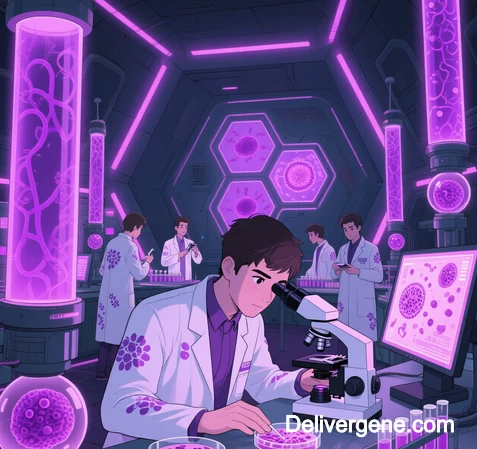
1. Viral Vectors: Nature’s Precision Infiltrators
Viral vectors leverage evolved biological mechanisms to achieve high-efficiency gene delivery, constituting the majority of clinical gene therapies.
A. Adeno-Associated Virus (AAV)
- Structure: Non-enveloped, single-stranded DNA virus (4.7 kb capacity)
- Key Advantages:
- Low immunogenicity and non-pathogenicity
- Serotype-specific tropism (e.g., AAV9 crosses blood-brain barrier)
- Long-term episomal expression in post-mitotic cells
- Clinical Applications:
- Ocular: RPE65 gene replacement for Leber congenital amaurosis
- Neuromuscular: Micro-dystrophin delivery for Duchenne muscular dystrophy
Suggested Figure 1: AAV Capsid Engineering
[Illustration:
- Left: AAV capsid proteins (VP1/VP2/VP3) forming icosahedral symmetry
- Center: Genome packaging via ITR-flanked transgene
- Right: Receptor-mediated entry (HSPG binding)]
B. Lentivirus (LV)
- Structure: Enveloped RNA virus (8 kb capacity)
- Mechanism:
- Reverse transcriptase generates proviral DNA
- Integrase enables stable genome integration
- Applications:
- Ex vivo CAR-T cell engineering for leukemia
- Hematopoietic stem cell gene therapy
C. Adenovirus (AdV)
- Structure: Non-enveloped double-stranded DNA virus (36 kb capacity)
- Advantages:
- High transduction efficiency in dividing/non-dividing cells
- Strong transient expression
- Limitations: Potent immunogenicity
2. Non-Viral Vectors: Synthetic Precision Engineers
Non-viral systems offer customizable delivery with reduced safety risks.
A. Lipid Nanoparticles (LNPs)
- Composition: Ionizable lipids + PEG-lipids + cholesterol + nucleic acids
- Delivery Mechanism:
- pH-dependent charge switching
- Endosomal membrane disruption via lipid fusion
- Landmark Application: COVID-19 mRNA vaccines
Suggested Figure 2: LNP Architecture
[Illustration:
- Cross-section showing lipid bilayer encapsulating mRNA
- Surface PEGylation for stealth properties
- Ionizable lipids enabling endosomal escape]
B. Polymer-Based Carriers
| Polymer | Mechanism | Advantage |
|---|---|---|
| Polyethylenimine (PEI) | Proton sponge effect → endosomal rupture | High transfection efficiency |
| Poly(lactic-co-glycolic acid) (PLGA) | Biodegradable sustained release | Reduced cytotoxicity |
| Dendrimers | Multivalent DNA binding | Precise size control |
C. Physical Methods
- Electroporation: Electrical pulses create transient membrane pores for DNA/RNP entry
- Gene Gun: Gold nanoparticles coated with DNA accelerated into cells
- Sonoporation: Ultrasound-induced membrane permeabilization
3. Hybrid & Emerging Delivery Platforms
A. Virus-Like Particles (VLPs)
- Design: Viral capsids devoid of genetic material
- Advantages:
- Viral transduction efficiency without replication risk
- Customizable tropism via surface engineering
B. GalNAc Conjugates
- Mechanism: Trivalent N-acetylgalactosamine targets hepatocyte asialoglycoprotein receptors
- Applications: siRNA therapies for liver disorders (e.g., transthyretin amyloidosis)
C. Exosome-Based Delivery
- Natural Advantage:
- Innate biocompatibility and blood-brain barrier penetration
- Low immunogenicity
- Engineering: Loading with therapeutic RNAs via electroporation
Suggested Figure 3: Next-Generation Hybrid Systems
[Illustration:
- Top: VLP self-assembly (capsid proteins + cargo loading)
- Bottom: Exosome membrane fusion delivering CRISPR components]
4. Vector Selection Matrix: Matching Technology to Clinical Need
| Application | Optimal Vector | Rationale |
|---|---|---|
| Retinal Gene Therapy | AAV2/AAV8 | Localized delivery + long-term expression |
| In vivo Liver Editing | GalNAc-LNPs | Hepatocyte specificity + rapid uptake |
| CAR-T Cell Engineering | Lentivirus + Electroporation | Stable integration + manufacturing scalability |
| Vaccines | LNPs/mRNA | Rapid development + scalable production |
| CNS Disorders | AAV-PHP.eB/Exosomes | Enhanced BBB penetration |
5. Clinical Translation: Success Stories & Challenges
A. Triumphs
- Luxturna™ (AAV2): First FDA-approved gene therapy for inherited blindness
- Zolgensma® (AAV9): Spinal muscular atrophy treatment achieving 92% survival improvement
- COVID-19 Vaccines: LNPs enabling global mRNA vaccine deployment
B. Persistent Challenges
- Immunogenicity: Neutralizing antibodies against viral capsids
- Payload Capacity: AAV limitations for large genes (e.g., full-length dystrophin)
- Off-Target Effects: CRISPR delivery risks requiring refined control systems
6. Future Frontiers: Engineering the Next Generation
- AI-Driven Design: Machine learning predicting capsid-receptor interactions
- Gene-Activated Biomaterials: 3D-printed scaffolds releasing lentiviral vectors
- Synthetic Viral Vectors: De novo-designed capsids with programmable tropism
- Oral Delivery Systems: Engineered bacterial vectors for GI tract gene editing
Conclusion: The Delivery Revolution Continues
Gene delivery vectors represent the critical bridge between genetic engineering breakthroughs and clinical reality:
- Viral vectors dominate clinical applications with unparalleled efficiency
- Non-viral systems offer rapid deployment and reduced safety concerns
- Hybrid platforms combine the best of both worlds for next-generation therapies
As delivery precision reaches cellular resolution—with AAV serotypes achieving 40× enhanced CNS targeting and LNPs exceeding 95% encapsulation efficiency—this field will unlock cures for intractable genetic diseases, cancers, and neurodegenerative disorders.
Data sourced from publicly available references. For collaboration or domain inquiries, contact: chuanchuan810@gmail.com.
